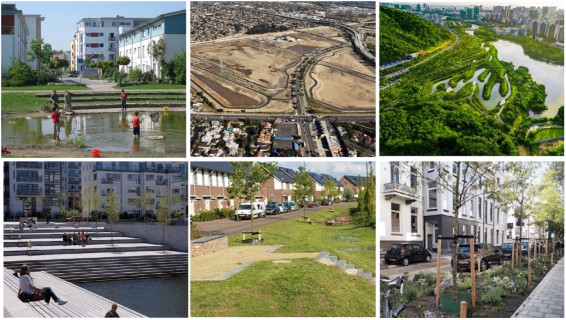This is the 12th episode of a series 25 building blocks to create better streets, neighbourhoods, and cities. This post deals with the question of how nature itself can help to deal with excessive rainfall and subsequently flooding of brooks and rivers, although these disasters are partially human-made.
Until now, flooding has mainly been combated with technical measures such as the construction of dykes and dams. There are many disadvantages associated with this approach and its effectiveness decreases. Nature-inclusive measures, on the other hand, are on the rise. The Netherlands is at the forefront of creating space for rivers to flood, where this is possible without too many problems.
Sponge areas
An important principle is to retain water before it ends up in rivers, canals, and sewers. The so-called sponge city approach can be incorporated into the fabric of new neighbourhoods and it creates sustainable, attractive places too. A combination of small and large parks, green roofs, wadis, but also private gardens will increase the water storage capacity and prevents the sewer system from becoming overloaded and flooding streets and houses. Steps are being taken in many places in the world; [China is leading the way](https://www\.dropbox\.com/s/47zxvl3kgbeeasa/Tale of two cities.pdf?dl=0) (photo top right). However, the intensity of the precipitation is increasing. In 2023, 75 cm of rain fell in Beijing in a few days. Under such conditions, local measures fall short. Instead, nature-inclusive measures must be applied throughout the river basin.
Retention basins
In new housing estates, water basins are constructed to collect a lot of water. Their stepped slopes make them pleasant places to stay in times of normal water level. The pictures on the left are from Freiburg (above) and Stockholm (below). The top center photo shows the construction of a retention basin in Lois Angeles.
Wadis
Wadis are artificial small-scale streams in a green bed with a high water-absorbing capacity. In the event of heavy rainfall, they collect, retain and discharge considerably more water than the sewer system (bottom center photo). Green strips, for example between sidewalks, cycle paths and roads also serve this purpose (photo bottom right: climate-adaptive streets in Arnhem).
Green roofs, roof gardens and soils
Green roofs look good, they absorb a lot of CO2 and retain water. The stone-covered urban environment is reducing the water-retaining capacity of the soil. Sufficiently large interspaces between paving stones, filled with crushed stone, ensure better permeability of streets and sidewalks. The same applies to half-open paving stones in parking lots.
Refrain from building in flood-prone areas
Up to the present day, flood-prone parts of cities are used for various purposes, often because the risk is underestimated or the pressure on space is very great. London's Housing and Climate Crises are on a Collision Course is the eloquent title of an article about the rapidly growing risk of flooding in London.
Hackney Wick is one of 32 growth centers set to help alleviate London's chronic housing shortage, which has already been repeatedly flooded by heavy rainfall. However, the construction of new homes continues. Measures to limit the flood damage at ground floor level include tiled walls and floors, water-inhibiting steel exterior doors, aluminum interior doors, kitchen appliances at chest height, closable sewers, and power supply at roof-level. Instead, floating neighbourhoods should be considered.
Follow the link below to find an overview of all articles.





